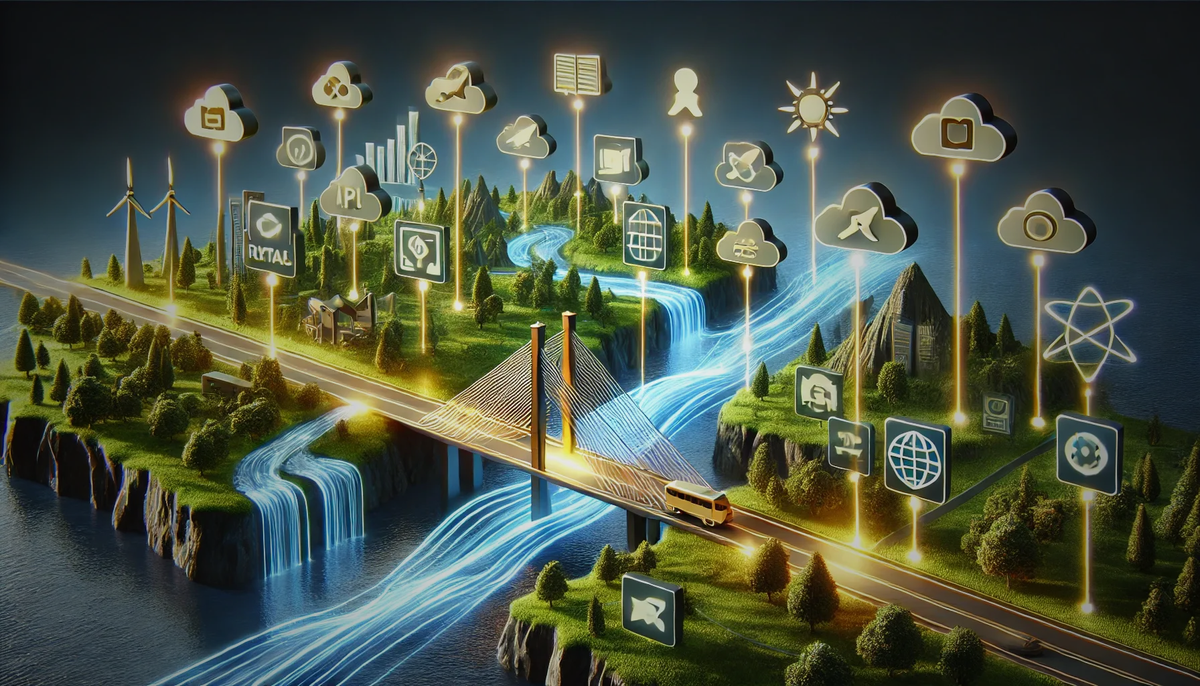APIs connect applications, making our devices smarter and our services more integrated. Learn more about their essential role.
Imagine that each application you use is like an isolated island in a vast ocean. How can these islands talk to each other and work together? The answer lies in a fundamental concept in the world of IT: APIs, or Application Programming Interfaces. The term may sound technical, but in reality it greatly simplifies our digital world. APIs are present in almost every action we perform on our connected devices, making our lives easier in invisible but essential ways. In this article, we'll explore what an API is, how it works, why it's so essential to our everyday lives, and even why it might be interesting for you to learn more.
What is an API ?
An API, or Application Programming Interface, is a kind of ‘bridge’ that allows two applications to communicate with each other. Imagine you go to a restaurant and ask the waiter for a dish. You don't care how the kitchen prepares your dish, you just wait for the waiter to bring it to you. The API works the same way: it transmits requests between two different systems, without you needing to understand how it works behind the scenes. An API specifies how a request should be made, what information is required, and how the response will be presented - just like a menu that details what you can request and how you will receive it.
Why APIs are Crucial
APIs play a fundamental role in most of the technologies we use today. Without them, there would be no connectivity between services and applications, and the user experience would be greatly affected. Here are a few reasons why they are so important:
- Connectivity and Integration: APIs allow different services and applications to work together. For example, when you use a travel application that lets you book a hotel, flight and rental car, it connects to several services via APIs. Think of each feature as a different part of the jigsaw; the API is what brings these pieces together to deliver a seamless and consistent experience.
- Innovation and efficiency: APIs allow developers to integrate existing services instead of recreating them. This encourages innovation and saves time by using pre-established functionality such as payment systems or location-based services. Many developers are able to create complex and innovative applications thanks to the possibilities offered by public APIs such as those from Google, Twitter or Stripe.
- Digital Economy: Many companies use APIs to monetise their services. For example, payment platforms such as Stripe provide an API that businesses can integrate to accept online payments. This creates an entire economy around APIs, where services can be shared, sold and used by different entities without having to recreate the wheel. Companies like Google and Amazon have even built a significant part of their business on APIs, allowing third parties to access their technologies.
The most popular types of API
There are several types of API, each designed for particular uses. Here are the three most common:
- REST: The REST (Representational State Transfer) API is widely used for web applications. It is simple, flexible and uses web standards such as HTTP. REST is often preferred because it is easy to implement and understand, making it an ideal choice for a wide variety of applications.
- SOAP: SOAP (Simple Object Access Protocol) is a more complex protocol that is often used in contexts where security is crucial, such as financial services. SOAP is very strict about how messages are written and transmitted, making it ideal for situations where every detail counts. For example, banking and inter-bank transaction systems often use SOAP to ensure that every exchange is secure.
- GraphQL: Created by Facebook, GraphQL allows customers to request only the data they need, which can be more efficient than REST APIs. Unlike REST, which often returns complete data sets, GraphQL allows high precision in data retrieval, reducing unnecessary data transfer and improving performance.
APIs and Everyday Life: Real-life examples
APIs are so much a part of our everyday lives that we use them without even realising it. Here are a few examples of how APIs are everywhere:
- Order a Taxi: When you use an app like Uber, the app uses an API to access mapping services to locate you and find a driver. By using mapping APIs like Google Maps, Uber can offer a seamless user experience where every journey is optimised and personalised.
- Social Networking: When you share a YouTube video on Facebook, an API is used to integrate content from one platform with another. This integration makes interactions richer and enables content to be distributed quickly between different channels.
- Weather Services: Weather applications use APIs to connect to databases that provide real-time weather information. This information is then processed and displayed on your phone in seconds, using APIs to access constantly updated data.
- Online commerce: E-commerce sites use APIs to manage payments, stocks and delivery services. For example, when you buy a product on Amazon, an API connects the site to a secure payment system and logistics services to ensure delivery of the product.
- Banking services: When you carry out a banking transaction via a mobile application, the application uses APIs to connect to the bank's servers. This makes it possible to check your information, carry out transactions in real time, and ensure that your balance is updated correctly. These interactions take place in complete security thanks to the APIs, ensuring that sensitive data remains protected.
- Connected Objects (IoT) : Connected objects, such as smart thermostats or security cameras, use APIs to communicate with each other and with your smartphone. For example, a security camera can send notifications to your phone when motion is detected, all via an API that links the camera to an application on your device.
How do APIs work?
APIs work by sending requests and receiving responses. It's a simple three-step process, but one that has important technical implications for how interconnected systems work. Here's a simple example:
- Request: An application sends a request to the API to access information or a service (for example, the arrival time of a flight). The request is sent with well-defined parameters that the API understands.
- Processing: The API transmits the request to the target system, which processes the information. This may involve complex calculations, database searches or interactions with other systems. During this time, the user doesn't have to wait for long minutes - everything is designed to be fast.
- Response: The API sends the response back to the original application, which can then display the information to the user. For example, if you're looking for a restaurant nearby, the API returns a list of restaurants matching your query, ready for you to view on your screen.
APIs can also include security mechanisms, such as API key authentication or OAuth tokens, which ensure that only authorised applications can access the information. This adds a crucial layer of security, particularly where sensitive data is involved.
Conclusion: Why APIs are Essential
APIs are literally the heart of communication between applications in the digital world. They facilitate connectivity, encourage innovation, and enable the seamless integration of services. Without APIs, our phones, computers and even connected objects would be much less useful and much more isolated. Imagine a world where each device operates independently without ever exchanging information - that's exactly what a world without APIs would be like.
APIs are essential not only for developers, but also for businesses. They enable the creation of entire ecosystems of products and services that connect and complement each other. As a user, you benefit from more integrated, efficient and innovative services thanks to APIs. As a developer or entrepreneur, understanding and using APIs opens doors to infinite possibilities, enabling you to create new solutions and meet users' needs more quickly.
If this article has helped you better understand what an API is and why it's so important, don't hesitate to share it with your friends or colleagues. Whether you're a curious user, a developer or an entrepreneur, it's always interesting to discover new ways in which APIs can improve your projects and make it easier to create new features. Why not start exploring APIs yourself? Maybe you'll come up with some innovative ideas for transforming your current applications or even creating new services. Share this article, leave a comment, and let's explore the fascinating world of APIs together!


Comments ()